
III Marine Expeditionary Force is a formation of the Marine Air-Ground Task Force of the United States Marine Corps. It is forward-deployed and able to rapidly conduct operations across the spectrum from humanitarian assistance and disaster relief (HA/DR) to amphibious assault and high-intensity combat.
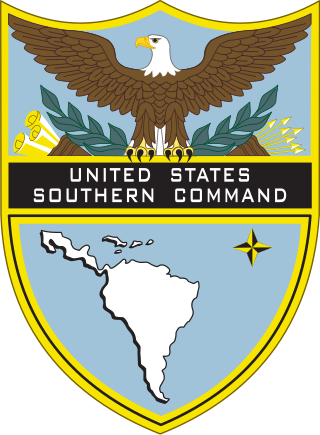
The United States Southern Command (USSOUTHCOM), located in Doral, Florida in Greater Miami, is one of the eleven unified combatant commands in the United States Department of Defense. It is responsible for providing contingency planning, operations, and security cooperation for Central and South America, the Caribbean, their territorial waters, and for the force protection of U.S. military resources at these locations. USSOUTHCOM is also responsible for ensuring the defense of the Panama Canal and the canal area.

The disaster recovery response to Hurricane Katrina in late 2005 included U.S. federal government agencies such as the Federal Emergency Management Agency (FEMA), the United States Coast Guard (USCG), state and local-level agencies, federal and National Guard soldiers, non-governmental organizations, charities, and private individuals. Tens of thousands of volunteers and troops responded or were deployed to the disaster; most in the affected area but also throughout the U.S. at shelters set up in at least 19 states.
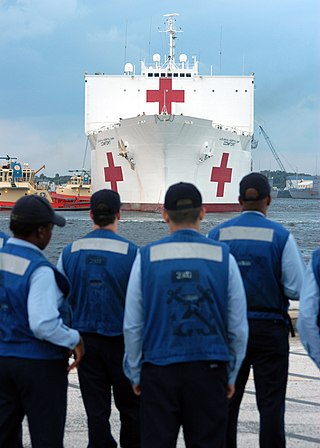
Joint Task Force Katrina was a joint operation between the United States Department of Defense and the Federal Emergency Management Agency created on September 1, 2005, at Camp Shelby, Mississippi to organize relief efforts along the Gulf Coast in the aftermath of Hurricane Katrina. The operation was headed by U.S. Army Lieutenant General Russel L. Honoré. Joint Task Force Katrina took over operations from United States Northern Command that had some elements in place before Hurricane Katrina struck the Gulf Coast.
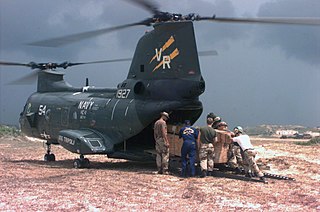
The Unified Task Force (UNITAF) was a United States-led, United Nations-sanctioned multinational force which operated in Somalia from 5 December 1992 until 4 May 1993. A United States initiative, UNITAF was charged with carrying out United Nations Security Council Resolution 794 to create a protected environment for conducting humanitarian operations in the southern half of the country.

Marine Medium Tiltrotor Squadron 264 (VMM-264) was a United States Marine Corps tiltrotor squadron consisting of MV-22 Osprey transport aircraft. The squadron, known as the "Black Knights", was based at Marine Corps Air Station New River, North Carolina, and normally fell under the command of Marine Aircraft Group 26 (MAG-26) and the 2nd Marine Aircraft Wing. They were the last east coast CH-46 Sea Knight squadron to transition to the Osprey. VMM-264 was decommissioned on June 24, 2020.

The 15th Marine Expeditionary Unit is one of seven such units currently in existence in the United States Marine Corps. The Marine Expeditionary Unit (MEU) is a Marine Air Ground Task Force (MAGTF) with a strength of about 2,200 personnel. The MEU consists of a command element, a reinforced infantry battalion, a composite helicopter squadron and a combat logistics battalion. The 15th MEU is currently based out of Marine Corps Base Camp Pendleton, California.

The 31st Marine Expeditionary Unit is one of seven Marine Expeditionary Units in existence in the United States Marine Corps. The Marine Expeditionary Unit is a Marine Air Ground Task Force with a strength of about 2,200 Marines and sailors. The 31st MEU consists of a company-sized command element, a battalion landing team (BLT),, a medium tiltrotor squadron (reinforced),, and a combat logistics battalion. The 31st MEU is based at Camp Hansen, Marine Corps Base Camp Smedley D. Butler, Okinawa, Japan. The 31st MEU is the only permanently forward-deployed MEU, and provides a flexible and lethal force ready to perform a wide range of military, humanitarian, and diplomatic operations as the premier crisis response force in the Indo-Pacific region.

The 26th Marine Expeditionary Unit is one of seven Marine Expeditionary Units currently in existence in the United States Marine Corps. It is an air-ground task force with a strength of about 2,400 personnel when at full strength during a deployment. It consists of four major parts: a command element, a ground combat element, an aviation combat element, and a logistics combat element. Since its establishment in the early 1970s as the 26th Marine Amphibious Unit, it has deployed extensively, and participated in numerous combat and contingency operations, as well as training exercises. The 26th MEU is based out of Marine Corps Base Camp Lejeune in the U.S. state of North Carolina.

Joint Task Force Lebanon (JTF-L) is a U.S. European Command (EUCOM) operational unit established in 2006 and assigned responsibility for U.S. military support to the American Embassy in Beirut and to help U.S. Department of State led humanitarian assistance efforts that are providing aid to the people of Lebanon. Led by Commander, U.S. Sixth Fleet Navy Vice Admiral John "Boomer" Stufflebeem, JTF Lebanon officially accepted the mission on August 23, 2006 from U.S. Central Command (CENTCOM) units, which had been operating in the region since mid-July 2006 shortly after hostilities began between Israel and Hezbollah militants based in Lebanon.

Joint Task Force-Bravo is a forward-based expeditionary joint task force operating as U.S. Southern Command's (USSOUTHCOM) lead forward element in the Central America (CENTAM) region to promote stability and security and counter transnational and transregional threat networks (C-T3N). JTF-Bravo operates out of Soto Cano Air Base, Honduras, located 10 miles south of the city of Comayagua and 50 miles north of the capital city of Tegucigalpa.

The 3rd Marine Expeditionary Brigade is a United States Marine Corps unit that is the "middleweight" crises response force of choice in the Pacific Area of Operation. It is the Marine Corps’ only permanently forward-deployed Brigade sized Marine Air-Ground Task Force and is a resilient, ready and relevant force able to rapidly deploy and conduct operations across the spectrum from humanitarian assistance and disaster relief to amphibious assault and high intensity combat. 3d MEB maintains a forward presence in the Pacific Theater to support contingencies and alliance relationships. 3d MEB also conducts combined operations and training throughout the region in support of United States national security strategy.

The 179th Airlift Wing is a unit of the Ohio Air National Guard, stationed at Mansfield Lahm Air National Guard Base, Mansfield, Ohio. If activated to federal service with the United States Air Force, the Wing is gained by the Air Mobility Command (AMC).

Operation Support Hope was a 1994 United States military effort to provide immediate relief for the refugees of the Rwandan genocide and allow a smooth transition to a full United Nations humanitarian management program. The inhabitants of the camp consisted of approximately two million Hutus, participants in the genocide, and the bystanders, who had fled Rwanda as the predominantly Tutsi Rwandan Patriotic Front took control of the country. On July 22, 1994 President Clinton announced Operation Support Hope. Two days later, American joint task forces were airlifted to Goma, Zaire; Kigali, Rwanda; Entebbe, Uganda; and Mombasa, Kenya. U.S. Air Force liaison officers were assigned to the United Nations High Commissioner for Refugees (UNHCR) air operations cell in Geneva and assigned to joint logistics cells and civil-military operations centers in the field.

Combat Logistics Battalion 31 (CLB-31) is a logistics battalion of the United States Marine Corps. CLB-31 is the Logistics Combat Element (LCE) of the 31st Marine Expeditionary Unit, the only continuously forward-deployed MEU in the Marine Corps.

The 864th Engineer Battalion is a combat engineer battalion of the United States Army based at Joint Base Lewis-McChord, Washington. The battalion is a subordinate unit of 555th Engineer Brigade.

United States Army Africa (USARAF), also known as the Southern European Task Force(SETAF), was the United States Army service component command of United States Africa Command.
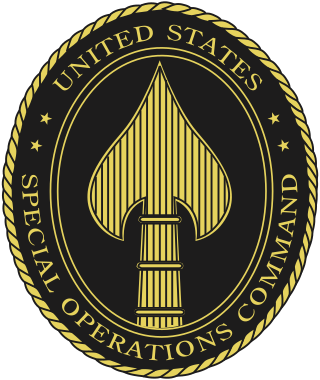
The United States Special Operations Command is the unified combatant command charged with overseeing the various special operations component commands of the Army, Marine Corps, Navy, and Air Force of the United States Armed Forces. The command is part of the Department of Defense and is the only unified combatant command created by an Act of Congress. USSOCOM is headquartered at MacDill Air Force Base in Tampa, Florida.

The 7440th Composite Wing (Provisional) was a Major Air Command-controlled (MAJCON) temporary wing of the United States Air Forces in Europe (USAFE), active in Turkey in 1991. The concentration of aircraft under the 7440th Wing's control made possible the opening of a "northern front" against Iraq, via Turkey, during the 1991 Gulf War.
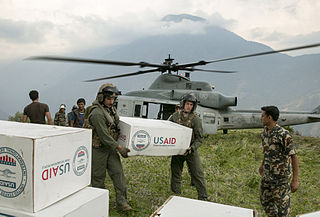
Operation Sahayogi Haat was a US military relief operation delivering humanitarian assistance to victims of the April and May 2015 Nepal earthquakes. About 900 US military and civilian personnel were involved, with about 300 deployed in Nepal. 3rd Marine Expeditionary Brigade was tasked to form Joint Task Force 505, which was responsible for managing the relief operation from May 6 to 26, 2015.



















